|
|
|
Sort Order |
|
|
|
Items / Page
|
|
|
|
|
|
|
| Srl | Item |
| 1 |
ID:
166127
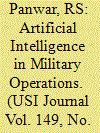

|
|
|
|
|
| Summary/Abstract |
Artificial Intelligence (AI) technologies hold great promise for facilitating military decisions, minimising human causalities and enhancing the combat potential of forces. This article focuses on development and fielding of Lethal Autonomous Weapon Systems (LAWS) against the backdrop of rapid advances in the field of AI, and its relevance to the Indian security scenario. It gives a broad overview of the possible military applications of this technology and brings out the main legal and ethical issues involved in the current ongoing debate on development of LAWS. Further, international as well as Indian perspectives are given out on the development and deployment of LAWS. It reviews the status of AI technology in India, assesses the current capability of the Indian Army (IA) to adapt to this technology, and suggest steps which need to be taken on priority to ensure that Indian defence forces keep pace with other advanced armies in the race to usher in a new AI-triggered Revolution in Military Affairs (RMA).
|
|
|
|
|
|
|
|
|
|
|
|
|
|
|
|
| 2 |
ID:
166135
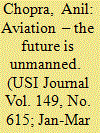

|
|
|
|
|
| Summary/Abstract |
Unmanned aircraft technologies have now matured. The world is at a transition. Dual use (optionally manned) aircraft are flying. Unmanned Combat Air Vehicles (UCAV) are being intensively used in combat with more and more drones being armed with air-to-surface weapons. Unmanned Aerial System (UAS) are taking-off and landing by themselves including on the moving aircraft carrier. Autonomous air refuelling has been tested. Unmanned stealth bombers are under development. Uninhabited helicopter convoys can be used for delivering supplies to troops deployed on combat front lines. Coordinated UAS swarms are already a reality and could also act as a multi strike decoy or jam the enemy defences through sheer numbers. UAS strikes will be a must to lead into territories with integrated air defences. UAS are now mostly being assigned the ‘Dull’, ‘Dirty’ and ‘Dangerous’ missions. UAS are also being used for missions like electronic attack or other non-lethal effects. By the year 2050 every conceivable mission, including heavy lift, would be unmanned. There are ethical and legal issues and also need for regulation. With no pilot inside, there is a risk of lowering the bar to using force. Also there is the risk of terrorists and non-state actors acquiring such assets. A casual hobbyist could by mistake fly a drone into an airliner. All these issues are being considered by regulators. Counter drone technologies are also evolving. India has to accelerate the development of Artificial Intelligence (AI) based weapon systems and platforms to stem excessive technological gap.
|
|
|
|
|
|
|
|
|
|
|
|
|
|
|
|
| 3 |
ID:
166126


|
|
|
|
|
| Summary/Abstract |
This article starts with an assertion that TIME and SPACE are constant factors of war and goes on to say that these factors take on variable values of impact at different timelines in history. Currently Time has drastically shortened, and Space has widened. It goes on to examine why kinetic weapons were weapons of choice and why ‘soft weapons’ are increasingly becoming important. The article asserts that War is a continuum with intensity ranging from non-contact across full spectrum anonymity strikes to visible effect limited spectrum kinetic strikes interspersed. Importantly, the article brings out that no longer are the Information age weapons in support or force multipliers to kinetic warfare. They are a potent arsenal of warfare, especially when war is not officially declared. Both kinetic, semi kinetic (Proxy) and non-contact warfare are blending into one whole war fighting machine spanning the Time and Space arena. The coming era will increasingly see nation level coordinated efforts between contact and non-contact warfare. Even in the contact warfare, emphasis will increasingly shift to long range highly lethal platforms which have least cost in terms of resources including human capital. Indicative scenarios are painted as illustrations. The article concludes by asserting the need to change for effective adaptation of the emerging format of war.
|
|
|
|
|
|
|
|
|
|
|
|
|
|
|
|
| 4 |
ID:
166134


|
|
|
|
|
| Summary/Abstract |
France is hardly mentioned in discussions pertaining to major stakeholders in the Indo-Pacific Region (IPR). With territories in both the Indian and Pacific Oceans, France is a resident power in the region. With its military power projection capability, strategic partnerships and arms agreements, it is actually a major player across the IPR. It is one of the few countries that have published an Indo-Pacific policy document. This article traces French interests and activities in the IPR to highlight its relevance in the region. This includes its territories, military presence, bilateral/ trilateral/ multilateral engagements, defence cooperation, arms exports, military deployments, and cooperation in the sectors of space and nuclear energy. The article highlights how this engagement is set to increase further due to the push by the European Union (EU) nations for strategic autonomy in the realm of security, with France leading the way.
|
|
|
|
|
|
|
|
|
|
|
|
|
|
|
|
| 5 |
ID:
166133
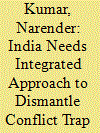

|
|
|
|
|
| Summary/Abstract |
Former President of Pakistan General Zia-ul-Haq once said, “Proxy wars are necessary to ‘keep the pot boiling”. Pakistan, with the help of terror organisations and separatists, has ensured that conflict in Jammu and Kashmir becomes a conflict trap for India. Pakistan is in a position to cause relapse of the conflict to deny space for dialogue and reconciliation whenever situation appears to become near normal. It is imperative to understand that gestation period for conflict resolution under such circumstances is long and thus the objective should be to adopt structured approach to achieve enduring peace. Though there may be a debate whether we are winning this war or it has reached a stage of stalemate, but strategy certainly is not failing in its entirety. Institutions of governance and democratic process have not collapsed and the instability has been restricted to Kashmir valley by sustained military operations and administrative initiatives. Though there may be a requirement to reorient and review the overall strategy, but the bottom line is to ensure that the terror organisations are made powerless and denied public and private space. Pulwama attack has displayed how brutal terrorists can be; however, this strategy is likely to bounce back on terror organisations and sooner or later genuine resentment among the masses against the acts of extreme brutality will rise. Emergence of new political wave is a welcome step and may challenge main stream political parties. This could be seen as the rise of youth against the dynastic politics and may bridge the gap between the youth and the State. Overall objective of the state should be to ensure that people feel empowered rather than disempowered.
|
|
|
|
|
|
|
|
|
|
|
|
|
|
|
|
| 6 |
ID:
166129
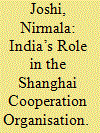

|
|
|
|
|
| Summary/Abstract |
The Shanghai Cooperation Organisation (SCO) comprises four Central Asian Republics (CARs), namely Kazakhastan, Kyrgyzstan, Tajikistan and Uzbekistan; Russia; China; India and; Pakistan. Russia and China are contiguous to Central Asia. India does not have a direct land boundary with the CARs. In Indian strategic thinking CARs are part of its extended neighbourhood. The Russian Federation and the People’s Republic of China have already established a strong presence in the Region and have initiated mega projects. It is an opportunity as well as a challenge for India to carve out a niche for itself in a Region that is of vital importance to it. The article explores the significance of regional grouping as well as India’s ability to play an effective role.
|
|
|
|
|
|
|
|
|
|
|
|
|
|
|
|
| 7 |
ID:
166131
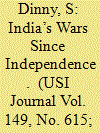

|
|
|
|
|
| Summary/Abstract |
The appointment of a CDS for the Indian Armed Forces is the single most procrastinated decision of the political establishment. From perceived fear of a possible military takeover, to pure government antipathy, to the turf wars between the Services, the issue of CDS has been on the backburner.
The radical changes undertaken by the US to facilitate evolution of Joint Chief of Staff into an institutionalised structure is an excellent case study. The ‘Goldwater-Nichols Department of Defence Reorganisation Act’ of 1986 completely transformed the US Armed Forces. India too had many opportunities where a CDS would have made an impact.
|
|
|
|
|
|
|
|
|
|
|
|
|
|
|
|
| 8 |
ID:
166132
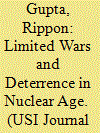

|
|
|
|
|
| Summary/Abstract |
Deterrence meant different things to different people at different times. Disagreement on the meaning of deterrence led to divergent interpretations. However, since the challenge which deterrence seeks to answer is capable of assuming different forms, the concept of deterrence too has unavoidably assumed different roles. Defined in simple words, deterrence means providing unmistakable evidence of retaliatory capacity to the enemy with a view to deterring him from initiating any military move for gains. It operates as the “skillful non-use of military forces”. General Beaufre said:
“The object of deterrence is to prevent an enemy power taking the decision when faced with a given situation to act or react in the light of the existence of a set of dispositions which constitute an effective threat. The result, which it is desired to achieve, is therefore a psychological one and it is sought by means of a threat.”
|
|
|
|
|
|
|
|
|
|
|
|
|
|
|
|
| 9 |
ID:
166136
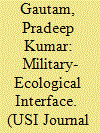

|
|
|
|
|
| Summary/Abstract |
The threats to national security have both, widened and broadened. Threats are no longer just militaries invading and conquering a country as in the past. Today threats such as ecological degradation and adverse impact of climate change are to be catered for by adaptation with resilience. Joint military doctrine recognises emerging non traditional challenges. This article traces contribution and interface by the military to ecological security. To understand contribution by the Indian military, a brief history of environmental stewardship with empirical examples of activities has been covered. The second part is about the way the United States (US) Indo-Pacific Command has institutionalised Environmental Security Forum. It achieves both, military to military cooperation and is a tool of military diplomacy. The article also recommends mechanism for addressing the present and future challenges.
|
|
|
|
|
|
|
|
|
|
|
|
|
|
|
|
| 10 |
ID:
166130
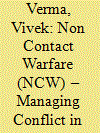

|
|
|
|
|
| Summary/Abstract |
The world has been devising strategy of winning without fighting. Over last three decades, terms like hybrid warfare, unrestricted warfare, asymmetric warfare, information warfare and political warfare have been used to define future warfare. At the heart of these is technology that has fuelled competitions and conflicts. The technological innovations have closely networked government, people and financial institutions. It has, for the first time, exposed people, political leadership, governance structures and economy to new generation threats emanating from non-contact warfare (NCW). Autonomous systems, miniaturisation, stealth, speed and stand-off precision strike, incognito platforms have changed the character of war. The technological developments have increased accessibility to state competitors and non-state actors, a fact that risks eroding military response capabilities. In such a dynamic and ever evolving world, non-contact warfare is being rampantly used and abused by all actors to remain ahead in the dominance race. It is imperative for India to evolve policies to thwart impending threats from NCW.
|
|
|
|
|
|
|
|
|
|
|
|
|
|
|
|
| 11 |
ID:
166125
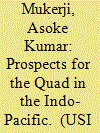

|
|
|
|
|
| Summary/Abstract |
Prospects for the Quadrilateral Security Dialogue (Quad) amongst Australia, India, Japan and the United States have been the focus of increased attention following the identification of an Indo-Pacific strategic framework, which has been endorsed by the four countries. The centrality of ASEAN in the Indo-Pacific has been emphasised by the Quad. To take the dialogue forward, the Quad needs to urgently converge existing divergences regarding their individual definitions of the Indo-Pacific. Equal participation of all four Quad countries in maritime security cooperation is crucial for a Free and Open Indo-Pacific region. Three issues which require priority attention for realising the full potential of the Quad are the identification of a common framework of international law to uphold a “rules-based order”; implementing connectivity projects with a view to integrating the hinterland of land-locked states of Asia and Africa into the Indo-Pacific region; and integrating the security of all the major sea lanes of communication in the broad Indo-Pacific region into the Quad’s strategic footprint. This will require upholding the principle of international cooperation, so that the Quad can contribute constructively to securing an inclusive Indo-Pacific at a time of increased great power rivalry.
|
|
|
|
|
|
|
|
|
|
|
|
|
|
|
|
| 12 |
ID:
166128


|
|
|
|
|
| Summary/Abstract |
While the present-day divide between Saudi Arabia and Iran has been framed in doctrinal and sectarian terms, it is the result of deep strategic vulnerabilities being felt in Riyadh in response to what is seen as the burgeoning role of Iran in areas that the kingdom views as its domain of exclusive influence – Lebanon, Syria, Iraq and Yemen. For the kingdom, this expanding influence is a “Shia Crescent” that is strangling it across West Asia and is an “existential” threat. Saudi Arabia has responded to the Iranian challenge by confronting Iran in the theatres of its influence – Syria and Yemen.
Given the deep hostility of the Trump administration for Iran, the robust United States (US) support to an Israeli-Saudi alliance against Iran in Syria and the interest of the US and its allies to effect regime change in Iran, there is a real prospect of a direct military conflict between the two major Islamic neighbours.
This article proposes that India, that enjoys extraordinary goodwill and standing with all the principal countries of the region, shape a peace process that would lead to dialogue between the kingdom and Iran and, over time, would lead to negotiations to realise a regional security cooperation arrangement in West Asia.
|
|
|
|
|
|
|
|
|
|
|
|
|
|
|
|
| 13 |
ID:
166124
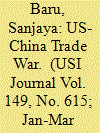

|
|
|
|
|
| Summary/Abstract |
The escalation of tariffs by the United States (US) on imports from China has launched what has been called a “trade war”. While economists generally do not approve of such actions and view them as zero sum games, the US-China tiff should be viewed as part of a political response, externally to China’s growing assertiveness and internally to domestic criticism of China, by an increasingly depressed US working class that supports President Donald Trump. While President Trump initiated the action, there is bipartisan support in the US to actions that would limit China’s rising power. The US action should be viewed as part of a “geo-economic containment” of China’s economic growth. The US hopes a growth slowdown would hurt China economically and its present leadership politically.
|
|
|
|
|
|
|
|
|
|
|
|
|
|
|
|
|
|
|
|
|